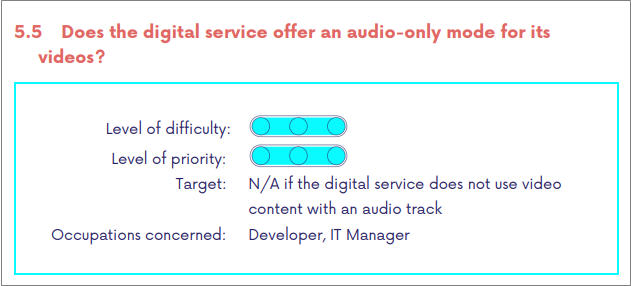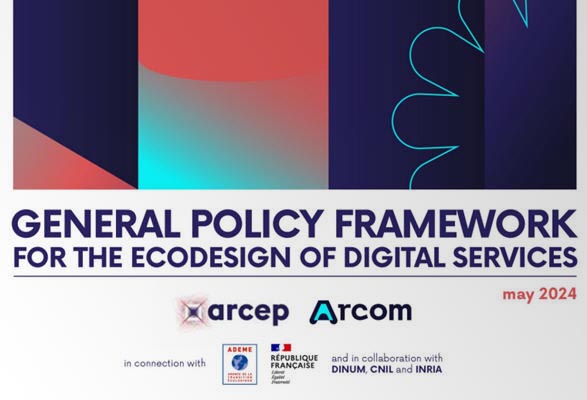What changes in 2024
The 2024 version of the general policy framework for the ecodesign of digital services (“RGESN”), co-constructed by Arcep and Arcom, presents several notable differences from the previous version.
It proposes a prioritization of criteria: Priority, Recommended and Moderate. This makes it easier to guide efforts according to the estimated environmental impact and the complexity of implementing each criterion.
- The 2024 framework comprises 78 criteria, accompanied by detailed practical sheets providing specific instructions for their implementation and validation.
- Version 2024 emphasizes transparency through the mandatory publication of an ecodesign declaration. This declaration aims to inform users of the environmental efforts undertaken by digital services, and to enable the calculation of a score to monitor ecological performance.
- Four new major objectives have been defined: extending the life of terminals, promoting environmental sobriety, optimizing the use of IT resources, and increasing transparency on the environmental footprint of digital services.
- The 2024 version was drawn up with extensive public consultation and consultation workshops to incorporate the opinions of all stakeholders.
Streamlike took part in the consultation, and our contribution is clearly visible in the criteria adopted for video.
The criteria are divided into 9 categories and described in 78 practical sheets. In the “Content” category (page 102 of the PDF), criterion 5.5 is directly inspired by a feature that Streamlike is currently the only platform to offer: an “audio only” mode. This criterion is presented as a “priority”:

Who is concerned by the framework?
A “Digital Service” is a website, application or online service. The eco-design of a digital service aims to reduce its environmental footprint through…
- a more sustainable design, (backward) compatibility with older terminals
- a sober approach to usage
- reducing the resources used (optimizing traffic, efficient hosting, data compression, limiting requests, etc.)
- minimum measurement of greenhouse gas emissions for a multi-criteria evaluation of the environmental footprint.
If a website integrates or references videos, the eco-design of the video host must be taken into account. In other words, the publisher of the digital service must consider the environmental impact of the videos it hosts on YouTube or Streamlike.
Streamlike Compliance with the 2024 framework
To evaluate the Streamlike platform according to the criteria of the 2024 version of the general policy framework for the ecodesign of digital services, let’s examine aspects of Streamlike related to the recommendations of the framework, particularly regarding video. The main recommendations for video in the 2024 are:
- Optimization of Bitrate and Resolutions: Adapt the quality of videos to usage and network capabilities.
- Reduction of Multiple Encodings: Limit the number of encodings to save resources.
- Adaptive Streaming: Use techniques that adjust video quality based on network conditions.
- Minimization of Energy Consumption: Use eco-friendly data centers and measure greenhouse gas emissions.
Adaptive Streaming and Bitrate Optimization:
Streamlike employs adaptive streaming, which means the video quality is adjusted according to the available bandwidth. This reduces data consumption and improves user experience without wasting resources.
Reduction of Multiple Encodings:
Streamlike limits the number of encodings to the strict minimum necessary, aligning with the repository’s recommendations to reduce resource usage. Additionally, Streamlike avoids multiple codecs (which increase processing and storage requirements) to prioritize universality and maximum backward compatibility with older devices.
Minimization of Energy Consumption:
Streamlike is notable for its commitment to digital sobriety and responsible streaming. The platform provides tools to measure greenhouse gas (GHG) emissions and operates from a carbon-neutral data center. This approach helps track and reduce the carbon footprint of the provided digital services.
Other Ecodesign Practices:
Streamlike implements best practices recommended by the framework, such as avoiding autoplay, limiting requests and metadata loading, contextually limiting bitrate, offering an “audio-only” mode, and restricting content suggestions, thus reducing unnecessary traffic and energy consumption. Additionally, it offers archiving and deletion options for videos to manage content sustainably.
Streamlike meets all the criteria of the 2024 version of the “RGESN” regarding the management and distribution of videos. The platform implements robust ecodesign practices, including adaptive streaming, minimizing encodings, and environmentally friendly data and infrastructure management. These efforts make Streamlike a solution aligned with digital sustainability goals.
For detailed explanations on how Streamlike meets the video-related criteria for drafting your ecodesign declaration, please contact us.
